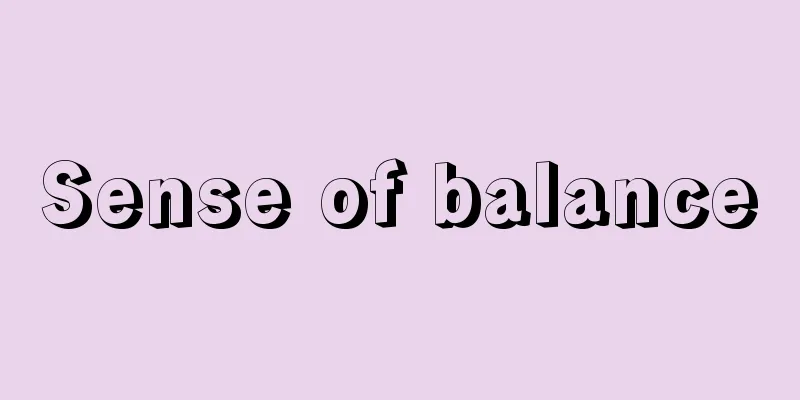Sense of balance

|
Humans can sense linear and rotational acceleration, even without skin sensation, deep sensation, and vision. This sense is called the sense of balance or vestibular sense. The sense of balance allows the living body to sense the posture and movement of the whole body, as well as the relative position of the whole body in space. The balance of posture and movement, as well as eye movement, are also reflexively adjusted by the sense of balance. The receptors for the sense of balance are the hair cells in the three mutually perpendicular semicircular canals (the trisemicircular canals) and the vestibular organs (the utricle and saccule) in the bony labyrinth in the inner ear. Rotational movement is sensed by hair cells at the apex of the ampulla of the semicircular canals, and linear movement is sensed by hair cells in the macula balanca of the vestibular organs (an oval-shaped part on the inner wall of the utricle and saccule). The vestibular nerve, which is distributed to these hair cells, merges with the cochlear nerve and terminates in the vestibular nucleus of the medulla oblongata and the cerebellum. Some secondary neurons descend to the spinal cord, while others ascend to the cranial motor nuclei that control eye movements. However, the pathway that ascends to the cerebral cortex via the thalamus has not yet been fully elucidated. The hair cells arranged in the stasis maculae carry small crystalline bodies called otoliths (otoliths). When the head is tilted or the body moves in a straight line, the stasis stones move relative to the hair cells, changing the pressure and the direction of the pressure on the hair cells. This allows the head position and the body's straight line movement to be sensed. When the body rotates, the flow of endolymph in the semicircular canals is delayed due to inertia, causing the ampulla apex to tilt in the opposite direction to the direction of rotation. As a result, the hair cells become excited and the frequency of impulse firing from the vestibular nerve changes. However, when the rotation stops, the endolymph flows in the direction of rotation due to inertia, and the ampulla apex tilts in the same direction as the direction of rotation. The semicircular canals are perpendicular to each other, and there are three on each side, so rotational movement is analyzed in three dimensions. This allows the direction and degree of rotation of the body in any direction to be correctly sensed. The sudden movement of the eyes that is characteristic of the beginning and end of a rotational movement is called "nystagmus". In other words, the eyes begin to move slowly in the opposite direction to the direction of rotation to follow the gazed object, and when this pursuit movement is about to end, they suddenly move in the same direction as the direction of rotation to find a new gazed object. This repetition of slow and fast movements of the eyes is nystagmus. Nystagmus is a reflex movement that fixes the gaze on the gazed object when the body is rotating. In addition, when a liquid that is warmer or colder than body temperature is placed in the ear canal, the temperature difference with body temperature induces convection of endolymph, causing movement at the apex of the ampulla. As a result, symptoms associated with the reflex such as nystagmus (called thermal nystagmus), dizziness, and nausea may appear. In addition, excessive stimulation of the vestibular organ may cause nausea, blood pressure fluctuations, sweating, pallor, and vomiting. An example of this is seasickness. Vertigo is the sensation of rotation even though no rotation is actually occurring. [Masamichi Ichioka] Animals and balanceThe sense required for animals to orient themselves in the direction of gravity and maintain mechanical balance is called the sense of balance, and the receptors that underlie this sense are called balance receptors or organs of balance. The most common organs of balance are statocysts, which are small capsules formed by invagination of the ectoderm, with sensory hairs growing on the inner surface. Inside the statocyst, there is usually a single statolith or a mass of statolith, and when it touches sensory hairs in different places, it detects the inclination of the animal's body axis. The sensory hairs of jellyfish and mollusks in cnidarians are cilia with a structure similar to that of motile organelles. The hair cells of the utricle and saccule of the vertebrate vestibular apparatus have cilia called kinocilia and microvilli called stereocilia. The sensory hairs on the statocysts of arthropods are setae with a cuticular apparatus similar to that of the sensilla on the body surface. In addition to the aforementioned vestibular apparatus, which is a receptor for the direction of the body axis relative to gravity and linear acceleration movement, the balance organs of vertebrates also include the semicircular canals, which are receptors for rotational movement. The sense of balance is closely related to vision, and stimulation of the semicircular canals causes eye movement (nystagmus), and the illusion of rotational movement causes dizziness. [Akira Murakami] [Reference] |©Kanzo Otawa "> Examples of planktonic gastropod statocysts Source: Shogakukan Encyclopedia Nipponica About Encyclopedia Nipponica Information | Legend |
|
ヒトは皮膚感覚や深部感覚、視覚を除いても、直進加速度や回転加速度を感ずることができる。この感覚を平衡感覚あるいは前庭感覚という。平衡感覚によって、生体は全身の姿勢と運動、全身の空間における相対的位置などが感知される。また、姿勢と運動の平衡や眼球運動も、平衡感覚によって反射的に調整される。 平衡感覚の受容器は、内耳内に存在する骨迷路にあって互いに直交している三つの半規管(三半規管)と前庭器官(卵形嚢(のう)と球形嚢)とにある有毛細胞である。すなわち、回転運動は半規管膨大部にある膨大部頂の有毛細胞によって、また、直進運動は前庭器官の平衡斑(はん)(卵形嚢と球形嚢の内壁の一部にある楕円(だえん)形部分)にある有毛細胞によって感じられる。これら有毛細胞に分布している前庭神経は、蝸牛(かぎゅう)神経と合流して延髄の前庭神経核と小脳に終わっている。二次ニューロンには脊髄(せきずい)に下行するものと、上行して眼球運動を統御する脳神経運動核に達するものとがある。しかし、視床を経て大脳皮質に上行する経路は、まだ十分には明らかにされていない。 平衡斑に配列する有毛細胞には、平衡石(平衡砂(さ)・耳石(じせき))とよぶ結晶状の小体がのっている。頭を傾けたり、体が直進運動をすると、有毛細胞に対して平衡石の相対的移動がおこり、有毛細胞の受ける圧力やその作用方向が変わる。これによって頭の位置の変化や体の直進運動が感知されるわけである。また、体が回転運動をおこすと、半規管内の内リンパはその慣性のために流動が遅れ、回転方向と逆方向に膨大部頂を傾けることとなる。その結果、有毛細胞が興奮し、前庭神経のインパルス発射頻度が変わる。しかし、回転が停止すると、内リンパは慣性のために回転方向に流れ、膨大部頂は回転方向と同方向に傾く。半規管は、互いに直交し、左右に三つずつあるため、回転運動は三次元に解析される。このため、体の任意方向の回転に対して、その方向と程度とが正しく感知されることとなる。 回転運動の始めと終わりとにみられる眼球に特有な急激な運動を「眼振(がんしん)」(眼球振盪(しんとう))という。すなわち、眼球は注視物を追って回転方向とは反対の方向にゆっくりと動き始め、この追跡運動が終わりかかると、急に回転方向と同じ方向に動き、新しい注視物をみつける。このような眼球のゆっくりした運動と速い運動との繰り返しが眼振である。眼振は、体が回転運動中にあるとき、視線を注視物に固定する反射運動である。また、体温より温かいか、または冷たい液体を外耳道に入れると、体温との温度差が内リンパの対流を招き、膨大部頂に運動がおこる。この結果、眼振(これを温熱性眼振という)、めまい、吐き気などの反射に伴う症状を呈することがある。このほか、前庭器官が過度に刺激されると、吐き気、血圧の変動、発汗、蒼白(そうはく)、嘔吐(おうと)などのおこることがある。船酔いなどがその例である。なお、めまいとは、現実に回転運動が行われていないのに感じられる回転感覚である。 [市岡正道] 動物と平衡感覚動物が重力の方向に定位したり、力学的平衡を保ったりするために必要な感覚を平衡感覚といい、この感覚の基礎となる受容器を平衡受容器または平衡器官(平衡器)という。もっとも普遍的にみられる平衡器官は、外胚葉(はいよう)の陥入による小嚢の内面に感覚毛が生えたもので、平衡胞とよばれる。平衡胞の中には通常1個の平衡石または一塊となった平衡砂があり、それが異なる場所の感覚毛に触れることによって動物の体軸の傾きが受容される。刺胞動物のクラゲや軟体動物の平衡胞の感覚毛は、運動性小器官のものとほぼ同じ構造をもつ繊毛である。脊椎(せきつい)動物前庭装置の卵形嚢および球形嚢の有毛細胞には、動毛といわれる繊毛と、不動毛といわれる微絨毛(じゅうもう)がある。節足動物の平衡胞にある感覚毛は、体表の感覚子と同様のクチクラ装置をもった剛毛である。脊椎動物の平衡器官は重力に対する体軸の方向および直線加速度運動の受容器である前述の前庭装置のほかに、回転運動の受容器である半規管がある。平衡感覚は視覚と密接な関係があり、半規管が刺激されれば眼球の運動(眼振)がおこり、また回転運動感覚の錯覚によりめまいを生ずる。 [村上 彰] [参照項目] |©大多和鐘三"> 浮遊性腹足類の平衡胞の例 出典 小学館 日本大百科全書(ニッポニカ)日本大百科全書(ニッポニカ)について 情報 | 凡例 |
>>: Annexation - Heigou (English spelling)
Recommend
Ooka Echizen no Kami - Ooka Echizen no Kami
→ Tadasuke Ooka Source : Heibonsha Encyclopedia Ab...
Egeyama ruins - Egeyama ruins
<br /> The remains of a Yayoi period settlem...
Union - Rengo
Its official name is the Japanese Trade Union Conf...
Tughluq Timur (English spelling)
In this situation, conservative Mongolians who op...
Blagoev
1856‐1924 Bulgarian politician. Born into a poor p...
Actinolite (actinolite)
It is also called actinoambrosite, epidote or diab...
Armand Hippolyte Louis Fizeau
French physicist. Born in Paris. His father was a...
Sarcocheilichthys variegatus - Sarcocheilichthys variegatus
A freshwater fish of the Cyprinidae family. The Ja...
Ezo red flathead beetle - Ezo red flathead beetle
...Three species have been recorded from Japan, a...
Blood pressure monitor
A general term for a device that measures blood p...
Uyghur literature - Uyghur literature
Documents written in Turkish (Uighur) that were ex...
Bulbophyllum macraei (English spelling)
… [Ken Inoue]. … *Some of the terminology that me...
Kitakami River
It originates from Mt. Nanashigure (1,063 meters)...
Ex-Cathedra - Ex-Cathedra
...By extension, it also refers to the authority ...
Bondol, J.
…A set of seven tapestries on the theme of the Ap...

![Territorial church - Landeskirche [Germany]](/upload/images/67cd2ceb1b0a3.webp)







